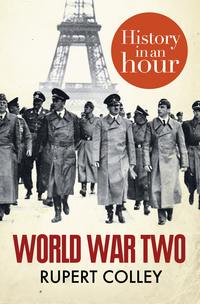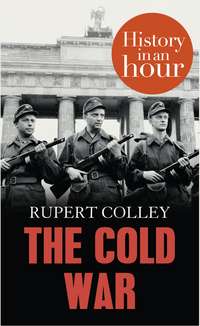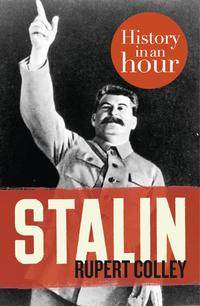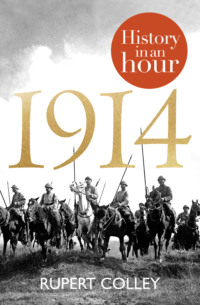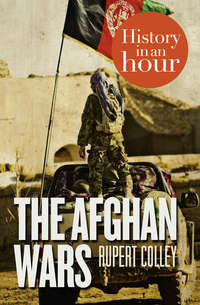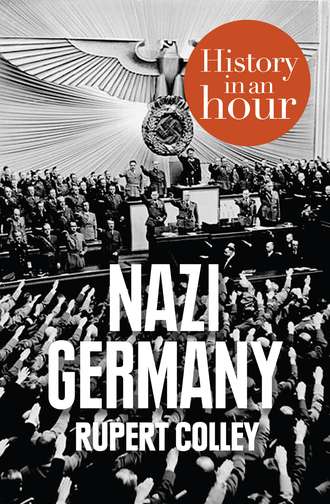
Полная версия
Nazi Germany: History in an Hour

NAZI GERMANY
History in an Hour
Rupert Colley

Contents
Cover
Title Page
About History in an Hour
Introduction
The German Revolution: The End of the Second Reich
The Treaty of Versailles: ‘An armistice for twenty years’
DAP: Member 555
The Nazi Manifesto: A Thousand Years
Munich Putsch: ‘The national revolution has begun.’
Mein Kampf: ‘Lies, Stupidity and Cowardice.’
The Ruhr: An Economic Downturn
The Great Depression: The Crash
Nazi Elections: ‘He can lick stamps with my head on them.’
Enabling Act: ‘Fanatics, hooligans and eccentrics have got the upper hand.’
The First Anti-Jew Laws: ‘Non-citizens’.
Night of the Long Knives: ‘The Führer’s soldierly decision and exemplary courage.’
The Führer: 99 per cent approval
Nazi Germany and the Economy: ‘Guns will make us strong; butter will make us fat.’
State Control: Guilty Before Innocent
The Family: ‘I detest women who dabble in politics.’
Propaganda: ‘Where they burn books, they will also ultimately burn people.’
The Olympics
Kristallnacht: The Night of Broken Glass
Foreign Policy: ‘Germany will of its own accord never break the peace.’
The Rhineland: ‘We have no territorial claims to make in Europe.’
The Spanish Civil War: ‘Germany’s destiny for good or bad.’
Anschluss: ‘I can strongly recommend the Gestapo to one and all.’
The Sudetenland: ‘The last major problem to be solved.’
Czechoslovakia: ‘That senile old rascal.’
Poland – Guaranteed
Germany’s War 1939: ‘This country is at war with Germany.’
Germany’s War: 1940 to 1941
Germany’s War: 1942 to 1945
Appendix 1: Key Players
Appendix 2: Timeline of Nazi Germany
Copyright
Got Another Hour?
About the Publisher
About History in an Hour
History in an Hour is a series of ebooks to help the reader learn the basic facts of a given subject area. Everything you need to know is presented in a straightforward narrative and in chronological order. No embedded links to divert your attention, nor a daunting book of 600 pages with a 35-page introduction. Just straight in, to the point, sixty minutes, done. Then, having absorbed the basics, you may feel inspired to explore further.
Give yourself sixty minutes and see what you can learn . . .
To find out more visit http://historyinanhour.com or follow us on twitter: http://twitter.com/historyinanhour
Introduction
‘And so it had all come to this. Did all this happen only so that a gang of wretched criminals could lay hands on the Fatherland? Hatred grew in me, hatred for those responsible for this deed.’ The words are those of Adolf Hitler; the deed – Germany’s surrender in the First World War; and the wretched criminals – the politicians who had meekly accepted the surrender and the defeat of Germany.
Germany had suffered during the war – not only on the battlefield but also at home. Starvation and fuel shortages, further aggravated by the ‘Spanish flu’ epidemic of 1918 that killed millions throughout Europe, had led to widespread discontent. Inflation and economic stagnation caused embitterment, and the increasing number of casualties as Germany had to fight a war on two fronts, had left the nation disillusioned.
The German Revolution: The End of the Second Reich
In October 1918, sailors at the port of Kiel disobeyed orders to fight the British fleet. It was, as they saw it, a pointless and suicidal mission. The revolt soon spread throughout Germany. The province of Bavaria went so far as to establish a socialist republic along Soviet lines. The Kaiser, William II, the unhinged grandson of Queen Victoria, abdicated on 9 November 1918, two days before the armistice, and the chancellor, Prince Max of Baden, appointed a left-wing coalition government and handed over the chancellorship to Friedrich Ebert.
With the abdication of the Kaiser and the collapse of Imperial Germany (the Second Reich – or empire), Ebert proclaimed Germany a republic, formed a provisional government (a temporary arrangement until elections could be held) and, on 11 November 1918, signed the armistice that brought the Great War to an end.
But the social unrest continued. In January 1919 the German Communist Party, the Spartacists, staged an uprising in Berlin. Rosa Luxemburg, leader of the movement, had opposed the uprising, arguing that the time was not yet right for communism. But she was unable to contain the fury of the left and Chancellor Ebert turned to the right-wing Freikorps, or Free Corps, for assistance. After three days of intense street fighting the Freikorps, a band of demobilized, nationalistic soldiers, had, with intense violence, crushed the rebellion. Luxemburg was arrested and killed while in police custody.
The Weimar Republic: A Republic Is Born
The first German democratic election took place the same month, January 1919, attracting an 83 per cent turnout and resulting in the formation of a National Constituent Assembly. The situation in Berlin was still volatile so on 6 February the Assembly met for the first time in the town of Weimar and there drew up a new constitution. Six months later the constitution was ratified and the Weimar Republic was born. However, disturbances continued, especially in Berlin and Bavaria, and Ebert again had to call in the Freikorps to keep order. In March 1919 the Freikorps went to work and the Socialist Republic in Bavaria was brought to a bloody end.
The Treaty of Versailles: ‘An armistice for twenty years’
On 28 June 1919, Germany reluctantly signed the Paris Peace Settlement in the Hall of Mirrors at the Palace of Versailles – exactly five years on from the assassination of Archduke Franz Ferdinand, the spark that had ignited the First World War. Germany had not been permitted to take part in the talks and was too weak, politically and militarily, to resist the dictated terms set by the representatives of thirty-two nations, led by the Allied powers – the US, Britain, France and Italy.
The terms were harsh and not for negotiation. Germany lost 13 per cent of her territory, which meant 12 per cent of Germans now lived in a foreign country, and Germany’s colonial possessions were redistributed among the other colonial powers. The German Rhineland, on the border with France, was to be demilitarized (stripped of an armed presence) and placed under Allied control until 1935. The small but industrially important Saar region was to be governed by Britain and France for fifteen years, and its coal exported to France in recompense for the French coal mines destroyed by Germany during the war. After fifteen years a plebiscite (or referendum) of the Saar population would decide its future.
Most of West Prussia was given to Poland. The German city of Danzig (modern-day Gdansk) was made a ‘free’ city so that Poland could have use of a port not situated in Germany. To give Poland access to Danzig, they were given a strip of land, the ‘Polish Corridor’, through Prussia, thereby cutting East Prussia off from the rest of Germany.
Militarily, Germany’s army was to be limited to a token 100,000 men, and its navy to 15,000, plus a ban on conscription. She was not permitted to have an air force, nor tanks, and was prohibited from producing or importing weaponry.
The payment of reparations was for ‘compensation for all damage done to the civilian population of the Allied powers and their property’. It was to include raw material, such as the coal from the Saar and Ruhr regions. Two years later, in 1921, the cost of reparations was announced – £6.6 billion, which German economists calculated would take until 1988 to pay. The figure shocked and angered Germans who conveniently forgot that Germany had demanded an even greater sum from a defeated France following the Franco-Prussian War of 1870–71.
But it was the humiliating clause that forced Germany into accepting responsibility for the war and for the damage to the civilian populations of the Allies that rankled most with the public at home.
The treaty satisfied no one. Germany was outraged. Britain thought it too harsh, believing an economically weak Germany would be detrimental to all Europe; the US, also considering it harsh, refused to ratify the treaty or to join the newly formed League of Nations; and the French felt it not harsh enough. It was they, the French argued, who had suffered most during the war. The French public were so dissatisfied with their president, Clemenceau, that they voted him out six months later, replacing him with Ferdinand Foch who, with sharp intuition, said, ‘This is not peace, this is an armistice for twenty years.’
The Weimar government, although democratically elected, was deemed responsible for Germany’s humiliation, and criticized by all sides for its weakness in standing up to the Allies. In March 1920 the Freikorps, led by Wolfgang Kapp, tried to seize power in Berlin but the coup, unable to gain the army’s support, failed.
DAP: Member 555
The Kapp Putsch, as it became known, may have failed but it illustrated the feeling of anger among the extreme right in Germany. Among the many small political parties was the German Workers’ Party or, to use its German abbreviation, DAP, set up in 1919 by 35-year-old Munich locksmith, Anton Drexler. The DAP, a far-right party that aimed at appealing to the workers, consisted of only about fifty members but, to give the impression of greater numbers, began their membership cards at number five hundred.
It was to a meeting of this party that in September 1919 Adolf Hitler, at this stage being groomed by the army as a political instructor, was sent to observe and speak. The beer hall meeting consisted of only about twenty attendees but Hitler’s speech so impressed Drexler that he was invited to join the party. With membership number 555, although he later claimed in Mein Kampf that he was the seventh member, he signed his name as ‘Hittler’.
NSDAP: Nationalism and Socialism under One Roof
Hitler’s oratory and leadership skills were evident and he soon took over from Drexler as the DAP’s leader. On 24 February 1920, still maintaining its peculiar mix of right extremism and socialist ideals, the party lengthened its name to the Nationalist Socialist German Workers’ Party, or NSDAP. Now boasting 3,000 members, the Nazi Party was born. Two months later Hitler resigned from the army to concentrate full time on expanding his party.
Corporal Hitler
Born in 1889 in Austria, Hitler spent much of his youth in Vienna, living in cheap accommodation, frequenting coffee houses and trying to sell his paintings. Art was his passion and his failure to secure a place at art school plunged him into depression. Resentment of the Jew was rife in the city and Hitler absorbed this anti-Semitism and, like many of his contemporaries, believed the Jew to be set apart from ‘the rest of humanity’.
At the outbreak of the First World War Hitler was in Munich and, having managed to avoid conscription into the Austrian army, signed up to a Bavarian regiment within the German army. He served as a messenger and did so with distinction throughout the war. Having no aspirations for promotion, he finished the war as a corporal having twice been awarded the Iron Cross and twice wounded – the second time in October 1918 when he was temporarily blinded by mustard gas.
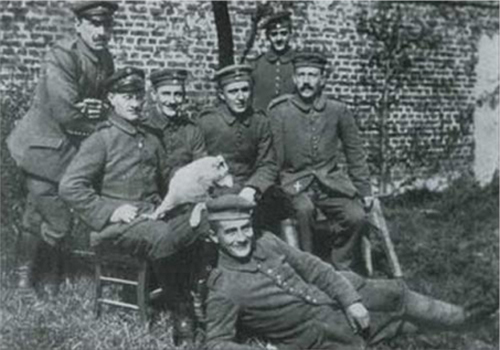
Adolf Hitler (right) during the First World War
It was during his recuperation that the armistice was signed, leaving Hitler and many other Germans embittered. Germany had won the war in the east, and following the ‘Spring Offensive’ of 1918, looked well placed to win it in the west. But a strike of German munitions workers towards the end of the war, believed to have been organized by Jews, disrupted the supply of arms and the front-line soldier suffered as a consequence. The government had accepted defeat and it was they, not the soldier, who had lost Germany the war. The signing seven months later of the Treaty of Versailles confirmed this sense of betrayal, the feeling that the German people had been ‘stabbed in the back’.
As the new leader of the fledging Nazi Party, Hitler met Hermann Göring and Rudolph Hess, two men who would serve him well over the next twenty years, and Ernst Röhm (pictured with Hitler), a tough ex-soldier and former member of the Freikorps, who went on to form the Nazi Storm Troopers (or SA).
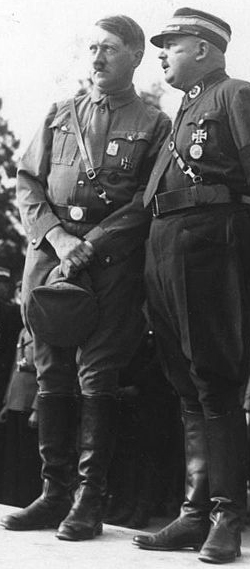
Hitler and Röhm, 1933
Bundesarchiv, Bild 146-1982-159-21A / Unknown / CC-BY-SA
The Nazi Manifesto: A Thousand Years
In February 1920 the party drew up its manifesto which, among its twenty-five points, demanded the union of all Germans into a greater Germany, and called for an expansion of living space to accommodate the growth of the German race. This space, Lebensraum, was to be found in the east at the expense of the Slavic races, who would, according to the party, be simply evicted.
The manifesto rejected the Treaty of Versailles – Germany needed to find her pride again and to rid the nation of the traitors who had so meekly accepted the peace of 1919. Hitler would lead such a Germany, a Third Reich that would reign for a thousand years.
The Jew, the source of German humiliation, was not and could not, stated the manifesto, be German. The manifesto maintained within its nationalist and anti-Semitic principles ones that were socialist in nature, designed to broaden its appeal to the German workers.
Nazism relied on the use of symbols – the swastika, which although far from new, was already identified with the Nazis, and, fifteen years later, in September 1935, was officially adopted as the national flag of Germany alongside a black, red and white tricolour. In September 1935, the flag of the Nazi Party was established as the. In Mein Kampf Hitler wrote about the colours of the flag: ‘In the red we see the social idea of the movement; in the white, the nationalist idea and in the swastika the vision of the struggle for the victory of the Aryan man.’
Munich Putsch: ‘The national revolution has begun.’
Such was Hitler’s hatred of the Weimar government he decided to overthrow it. On the evening of 8 November 1923, he led a group of 600 Storm Troopers and together they burst into a Munich beer hall meeting. The 34-year-old Hitler fired two shots from his revolver into the ceiling, declaring that he was the new leader of the German government and that the ‘national revolution has begun.’
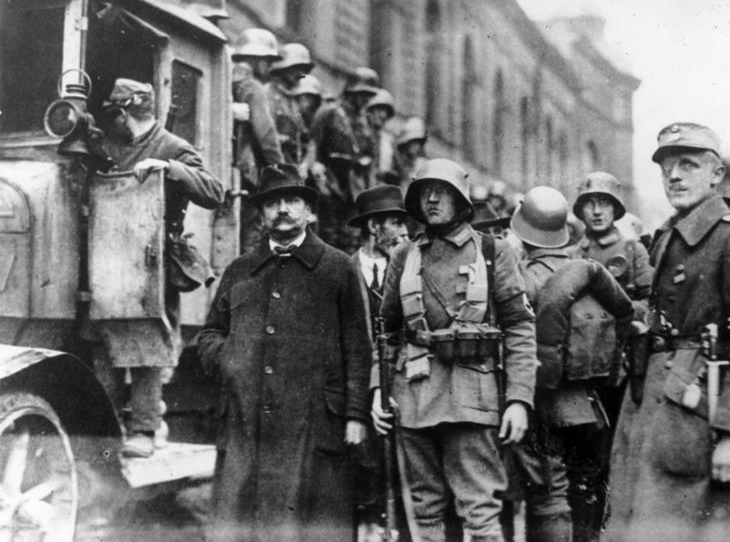
The Munich Putsch, 9 November 1923
Bundesarchiv, Bild 146-2007-0003 / Unknown / CC-BY-SA
Meanwhile, Röhm had seized the city’s war ministry. Hitler had expected the support of the army and the Bavarian police and then to march on to Berlin. But the support never materialized and the following day, as Hitler led 300 Nazis through the streets of Munich to meet Röhm, the police blocked their way. The Nazis refused to stop and the police opened fired, killing sixteen and wounding many more. Hitler hurled himself to the ground, dislocating his shoulder, then tried to make a run for it, but was caught and arrested. It was later claimed he was trying to get a wounded child to a hospital. The Munich Putsch may have failed but Hitler learnt a useful lesson – that power could not be secured through force but would have to be earned through legitimate means and the ballot box.
Mein Kampf: ‘Lies, Stupidity and Cowardice.’
Hitler was tried for high treason and could have faced the death penalty but got away with a lenient sentence of five years. He served less than nine months. Although frequently depressed and talking of suicide, Hitler used his time in prison constructively, dictating to Hess his autobiographical, ideological rant, Mein Kampf. Published in two volumes, the first on 18 July 1925, the second in 1926, it was originally entitled My 4½ Year Struggle Against Lies, Stupidity and Cowardice; the new title being suggested by his publisher.
Much of it is devoted to race; the need for a pure race of German Aryans, untainted by the blood of different races. The Aryan race was of the highest order, the ‘bearers of culture’; the Jewish race (Hitler defined Jews by race not religion) of the lowest. The aim was to eliminate the Jews (referred to throughout the book by various unpleasant metaphors: parasites, germs, vermin) from society. He expanded on many of the themes of the Nazi manifesto, including Lebensraum, the union of all German-speaking people and the treachery of the Treaty of Versailles. Mein Kampf sold poorly at first and a second book, written in 1928, was never published. However, by 1939, with Hitler firmly in power, it outsold all other titles in Germany with the exception of the Bible.
The Ruhr: An Economic Downturn
The Weimar government was struggling to pay the reparations demanded by the Treaty of Versailles. The views of the Allied powers differed: the US had taken the isolationist route and paid little interest to what was happening in Europe; while Italy was in the midst of a fascist takeover. Britain felt that Versailles had been too harsh and sought reconciliation with the Germans, and advocated a reduction in reparations to aid the recovery of the Germany economy, which, in turn, would benefit the economy of Europe as a whole. Only the French were determined that Germany should fully meet her obligations.
In 1923 the Ruhr industrialists had stopped supplying France the requisite quota of German coal. The French and Belgium governments, angered by this breaking of the rules, sent troops into the region (pictured below). When the German workers of the Ruhr, affronted by this occupation, refused to work for the French, the French government sent in its own workforce. The occupation of the Ruhr caused chaos for Germany’s economy, triggering a period of high unemployment and hyperinflation. The inflation wiped lifetime savings out overnight: in 1921 the mark was worth one dollar. Two years later it was an unimaginable 4,000,000,000,000 to the dollar.
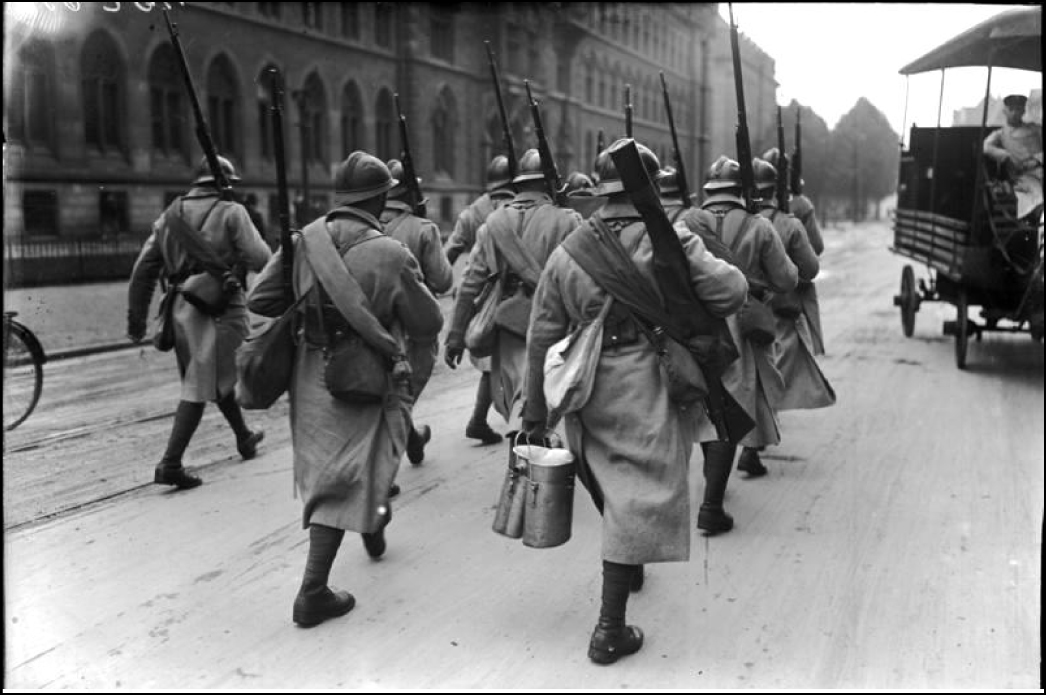
French soldiers during the occupation of the Ruhr, 1924
Bundesarchiv, Bild 102-00654 / CC-BY-SA
America began to realize, as had the British, that an economically unstable Germany would be detrimental to all Europe and tasked Charles Dawes, an American banker, to formulate a recovery programme. The Dawes Plan had the desired effect and from 1924 Germany enjoyed a period of relative prosperity. American loans and investment brought inflation down to a manageable level and unemployment fell. With American money, Germany began paying the French, Belgian and British reparations, albeit at a lesser rate, and the Allied nations, in turn, were able to start repaying their war debts to the US. It was an unending circular movement of money. By 1925 the French and Belgians had withdrawn from the Ruhr.
On the international stage too, relations between Germany and its European neighbours became less tense, ending Germany’s sense of isolation, and leading, in 1926, to Germany joining the League of Nations. In 1929, based on the recommendation of the American commissioned Young Plan (after its author Owen D. Young), reparations were cut by 75 per cent. Following the Great Depression payments were suspended for a year and by 1931 reparations were dropped altogether. Germany had paid back only an eighth of the original demand.
Following the failed Munich Putsch, Hitler’s name had become known throughout Germany. However, during the Weimar years of relative economic stability the Nazis were marginalized and, even on Hitler’s release, lacked electoral support, rarely polling more than 3 per cent throughout the 1920s.
The Great Depression: The Crash
It was the knock-on effect of America’s Great Depression that changed the political landscape in Germany. Following the Wall Street Crash of October 1929 America called in its worldwide loans on which Germany, especially, was overly reliant. The stable years had come to an abrupt halt.
Unemployment soared – in one month alone, January 1930, unemployment rose from 1.5 million to 2.5 million; by 1931, 4 million were unemployed; and by 1933, 6 million. The Weimar government, in an attempt to keep things under control, adopted a policy of deflation, causing severe wage cuts and further unemployment. Businesses went bankrupt, banks collapsed.
The Weimar government had failed its people. The country was in economic ruin, people’s livelihoods were shattered, and the nation, still burdened with the humiliation of Versailles, was fearful of the communists and the Jews. They looked for an alternative and that alternative lay in Adolf Hitler and the Nazi Party.
As unemployment rocketed so did the number of Nazi Party members, rising from about 120,000 members in mid-1929 to over a million within a year. This was reflected in the elections – from 2.5 per cent of the vote in May 1928 to over 18 per cent in September 1930.
Nazi Elections: ‘He can lick stamps with my head on them.’
However, it was 1932 that saw the rise of the Nazi Party into a prominent political force. In the July 1932 Reichstag elections the Nazi Party polled almost 40 per cent of the vote, making it the most powerful party. There was a slight dip in the elections four months later but the party still had enough electoral clout that Hitler, as dictated by the Weimar constitution, should have been appointed chancellor. But the Weimar president, the 84-year-old Paul von Hindenburg, was reluctant to appoint the former corporal: ‘That man a chancellor?’ he said, ‘I’ll make him a postmaster and he can lick stamps with my head on them.’
Конец ознакомительного фрагмента.
Текст предоставлен ООО «ЛитРес».
Прочитайте эту книгу целиком, купив полную легальную версию на ЛитРес.
Безопасно оплатить книгу можно банковской картой Visa, MasterCard, Maestro, со счета мобильного телефона, с платежного терминала, в салоне МТС или Связной, через PayPal, WebMoney, Яндекс.Деньги, QIWI Кошелек, бонусными картами или другим удобным Вам способом.




